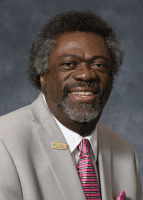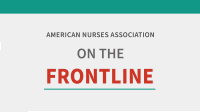Better representation key for profession’s workforce, health outcome goals
Men in nursing view their presence in the profession as vital for addressing social determinants of health and meeting the nation’s growing healthcare needs. Their lived experience, perspective, and clinical insights also can make much-needed inroads in improving men’s health, they argue. Yet men remain distinctly under-represented, comprising just 12% to 13% of RNs, according to data from the Bureau of Labor Statistics. Although this is up from 9.9% in 2013, the relatively modest percentage of men underscores the ground the profession needs to cover in achieving its diversity, equity, and inclusion goals, said men in the field.


“Our low numbers compared to our female colleagues or those who identify as female, causes a great deal of consternation because we’re leaving a huge workforce unutilized,” said ANA-NY member Sheldon D. Fields, PhD, RN, CRNP, FNP-BC, AACRN, FAANP, FNAP, FAAN, research professor and associate dean for equity and inclusion at the Penn State Ross and Carol Nese College of Nursing. “Men, like women, have other health professional career choices, and some men believe nursing is so overly feminized they don’t see themselves in the profession.” Fields also serves as president of the National Black Nurses Association and co-lead of the National Commission to Address Racism in Nursing.


Having more men in nursing matters because “nursing is a profession that can ultimately be a tool for social justice and advancing health equity,” stressed William Rosa, PhD, MBE, AGPCNP-BC, FAANP, FPCN, FAAN, an assistant attending behavioral scientist at Memorial Sloan Kettering Cancer Center. “Nursing is a bridge to what human beings need to live their best lives. Men, like women, are an integral part of society, and may find comfort in receiving care from people who represent the diverse populations they see in the community.” An ANA-NY member, Rosa will be recognized in June 2024 with the American Nurses Association (ANA) Luther Christman Award, which acknowledges substantial contributions made by an individual man in nursing to the profession.
Is nursing a stigmatizing label that needs to go?
The relatability quotient
Male providers serve as a powerful tool for engaging men in their healthcare, according to Jason Mott, PhD, RN, CMHE, associate dean of academics and student success at the University of Wisconsin Oshkosh College of Nursing. “Men in general don’t have a lot of health-seeking behaviors. Unless they have a spouse harping at them to see a provider, they don’t go because they feel okay,” he observed. “We don’t have enough people understanding this mentality and saying to them, ‘This is really why you need to get checked out even though you feel fine now’.” Mott also serves as president of the American Association for Men in Nursing.


Vittario Allen, BSN, RN, has experienced firsthand the inroads male nurses can make with male patients. An Army veteran, he ran into the wife of a patient, another veteran, in the cafeteria of the civilian hospital where the man was receiving care. “She thanked me and said, ‘He normally doesn’t open up to people taking care of him. But you’re a male, and a vet, and that’s something he could relate to’,” Allen, a Virginia Nurses Association Board of Directors member, recalled. He added, “Males may be more comfortable sharing certain things about their health with other men, and they may be more inclined to take advice from someone they can relate to.”
If men in nursing can connect in a distinct way with half the population, why has male representation in the profession advanced so slowly? For starters, Mott suggested a look back through history. Men in the military and religious orders served for centuries as nurses. But a radical transformation began in the mid-19th century, when women took on nursing roles during the Crimean War and American Civil War. Florence Nightingale, in establishing her training school for nursing upon which many others were based, made clear women were better suited to nursing than men. Even so, men persisted in the field, but as a clear minority. ANA explicitly allowed men as members in 1930. In modern times, even as career fields have opened widely for women, stereotypes and societal norms still hold men back from considering nursing.
Making the case for nursing
“When do we expose young males to the fact that nursing is a career option?” asked Fields. “No one tells those third, fourth, or fifth grade boys that they can be a nurse.”


Immediate Past President of ANA Ernest Grant, PhD, RN, FAAN—the only man to hold the ANA presidency—also emphasized the need to talk up nursing to youth at early ages. “I’ve always advocated that we need to start at lower grades to plant the idea of what nursing is and what we can bring to healthcare,” he said. Vice dean for diversity, equity, inclusion, and belonging at the Duke University School of Nursing, Grant volunteers with an organization that has adopted a third grade class in Durham, NC. “They’re seeing me come in, helping them with their reading, their math, but I’m planting in their mind, ‘This is a nurse’,” he suggested.
David Vilanova, DNP, AGACNP, noted the need to make the case for the profession more relatable to men. “We need to communicate better that nursing is a very rewarding career, play on the strengths of what it means to be a nurse and be in that unique healthcare provider role,” he suggested. A Connecticut Nurses Association member, Vilanova is an emergency nurse at Norwalk Hospital and received his DNP in May, 2024 from Georgetown University School of Nursing. He also emphasized the selling point of nursing to anyone as a stable, long-lived career choice with enormous flexibility and rewards.


Men’s reasons for joining nursing mirror those of their female colleagues, starting with having strong nurse role models. For instance, Mott had a family full of (female) nurse relatives, while Fields’ successful and respected Aunt Lorraine led him into the profession. Vilanova’s interest was piqued as a volunteer in high school for an ambulance service. Doing this, he recalled, “I didn’t get to be as involved with my patients as I wanted, and nursing was a way to have that meaningful interaction I was longing for.” Grant had his long-term sights set on medical school, but 3 months into his nursing program, “I realized that nursing was my calling and just totally forgot about medical school altogether. I felt that I could do more for my fellow man as a nurse,” he said. Rosa’s career as a dancer was cut short after a severe injury. A long rehab process interested him in a health profession. Weighing medical school or nursing he chose nursing because “I wanted the type of flexibility that nursing offered. I saw it as a launching pad to maximize my impact across different settings and populations,” he said.
Data from the American Association of Colleges of Nursing show male enrollment in nursing schools was stable between 2018 and 2022, varying from 12.6% to 12.9% among undergraduates, 11.7% to 12.2% among master’s students, and 10.5% to 12.2% among PhD candidates. Only among DNP students was there a sustained increase, from 13.4% in 2018 to 14.8% in 2022.
Recruitment and retention strategies
The stalled increase in male students and static overall percentage of men in nursing underscores the need for more innovative recruitment and retention strategies, said Fields. In his first year at Penn State there was one male student of color. The next year’s class had nine. Fields attributes this uptick to, among other things, his outreach, personally contacting the parents of prospective students, as well as targeted recruiting trips.
Healthcare organizations also would do well to support career paths in nursing and from allied health professions, according to Allen. He started as an Army medic and re-enlisted to become an LPN. While still in the Army he started on his BSN and now is an MSN-FNP candidate at United States University. Grant and Fields also began their careers as LPNs, seeing it as a way to support themselves while advancing in the field.
Vilanova also sees a need to better support male students through nursing school. He took on such an initiative himself while still an undergraduate, after seeing five of 10 male students in his class—especially those from historically marginalized backgrounds—drop out. In addition to building studying skills, Vilanova’s group sponsors outside speakers. “We brought in men who discussed what they’re doing, changing the stereotypical narrative that some people have that nursing is a female profession that’s only bedside nursing,” he explained.
Mott, Grant, and Fields all have taken pains to connect with male students. For example, Grant makes a point to sit informally with students during lunch. “I’ll go down and mingle with them and just have that openness so they know that they can come to me and talk about things they may be experiencing,” he said. Fields has taken aim at course materials that use only female pronouns to describe nurses.
Changing demographics and societal norms bode well for diversifying nursing, he noted. “The younger generations are more gender fluid than older nurses, and I don’t think the stereotype of nursing as a female-predominant profession bothers them as much as it bothers older generations,” he observed. The 2022 National Nursing Workforce Survey bears out this change, with male and nonbinary respondents skewing younger than female participants. Notably, 31% of nonbinary respondents were ages
18 to 29.
Even as new demographics emerge, old patterns persist. The 2022 National Nursing Workforce Survey found that male respondents earned more than their female counterparts in 14 of 21 specialties. Men also punch above their weight when it comes to top leadership positions. Online search company Zippia estimates that 23% of CNOs are men.
While these inequities reflect the ongoing professional challenges women face, men in nursing argued they don’t invalidate the contributions men are making to the field. They urged colleagues to welcome all aspects of diversity in nursing. “Fundamentally, it’s about representation, not just genders. We need more representation of people of various backgrounds in nursing, because we need a population that’s as diverse as the people we care for,” said Matthew French-Bravo, PhD, MSN, RN, director of consumer experience at Ascension Via Christi.
Open dialogue and collaboration
Men emphasized their spirit of openness with their colleagues in further evolving nursing. “We need to open dialogue about creating more welcoming and inclusive spaces for men and other marginalized groups in nursing,” said Rosa. “It’s okay to invite uncomfortable conversations with me and discuss hard topics.” He added that while he’s felt welcomed overall in nursing he has experienced “very clear moments of exclusion.”
Rosa isn’t alone in having faced adversity in nursing. Although their clinical settings were welcoming, Mott and Fields reported that they received pushback in academia.
Despite these headwinds, men in nursing see a bright future for a more diversified, inclusive profession. As Rosa put it, “With the support of mentors and colleagues I’ve been able to walk through so many doors as a nurse, and I take great pride in representing the profession and increasing the visibility of what we do and are capable of.”
— Genna Rollins is a writer/editor at ANA
American Nurse Journal. 2024; 19(6). Doi: 10.51256/ANJ062448





















1 Comment. Leave new
I was one of the first male nurses in my state. I felt no problem with being accepted by female nurses, doctors or any other health care providers. I am retired now but I originally wanted nursing because it offered guaranteed employment and a pay rate that was getting better with each passing year. Plus, helping individuals with their health and watching them get better, in most cases, was always rewarding. I would highly recommend it to any male considering it.